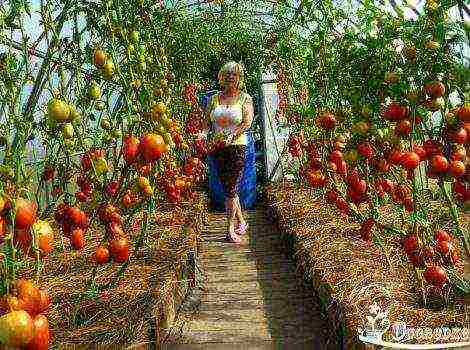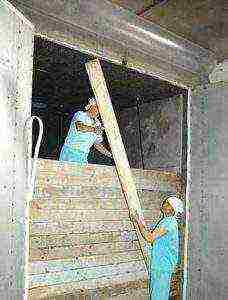Content [show]
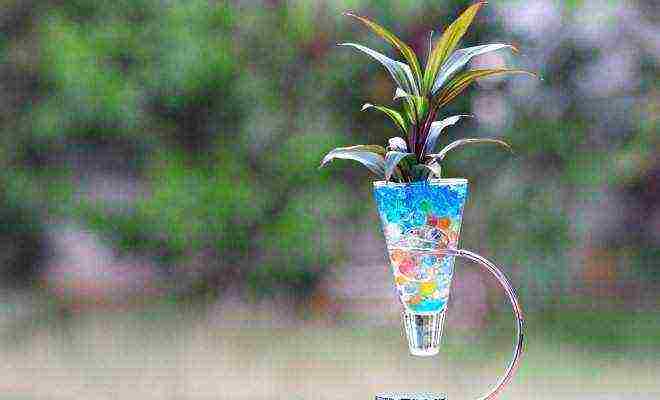
The hydrogel is capable of absorbing and retaining moisture for a long time, which makes it very useful in the flower industry. How can the substance be used?
Hydrogel is a polymeric compound that is actively used in agriculture, and recently florists and phytodesigners have also paid attention to it. Plants can be planted directly in the hydrogel, or you can mix the substance with soil for indoor flowers. The liquid that the hydrogel absorbs does not evaporate or flow onto the tray, and also does not lose nutrients.
Planting plants in a hydrogel
A plant in a hydrogel can become not just an interior decoration, but also an excellent gift, because it looks very original. The hydrogel is commercially available in various colors, so it can be used to create a very bright and beautiful composition. The cost of the substance is not very high, and its consumption is quite small, so one sachet will be enough for a long time.

Hydrogel granules
Tableware. Containers for planting plants should be chosen transparent so that the balls or pieces of hydrogel are clearly visible. As for the shape of the vessels, it can be absolutely any (when planting plants in a hydrogel, the possibility of damaging the roots is minimized). For small plants growing in rosettes, glass goblets can be chosen, and for larger specimens, round or cylindrical vases are suitable.

Glass containers with hydrogel
Hydrogel preparation... You need to fill in the hydrogel with clean water suitable for irrigation (settled, distilled). For 1 g of dry matter, about 300 ml of liquid can go away. It is best to look at the required proportions on the packaging.
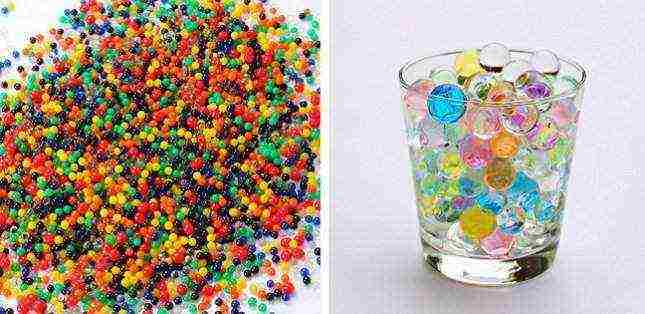
Hydrogel
What plants can be grown in a hydrogel? Grow well in polymer absorbent shefflera, chlorophytum, dracaena, tradescantia, syngonium, cordilina, scindapsus... Suitable for shaded corners of the apartment spathiphyllums, ficuses and sansevieria... Some growers grow flowering plants in hydrogel: Kalanchoe, Guzmania, Tilandsia and anthurium.
Do not plant flowers in the hydrogel that do not need frequent watering. For example, most succulents and epiphytes store moisture in leaves and roots, and being in a humid environment will cause them to rot.
Landing. Planting flowers in a hydrogel does not fundamentally differ from planting in ordinary soil. First, the roots of the plants must be rinsed well under running water so that no parts of the old soil remain on them.Next, the container for planting must be filled with a hydrogel, the plant should be placed in it and a little more substance added. That's all, nothing complicated. The only thing to watch out for is to keep the plant upright (this can be a problem as the hydrogel is very slippery).
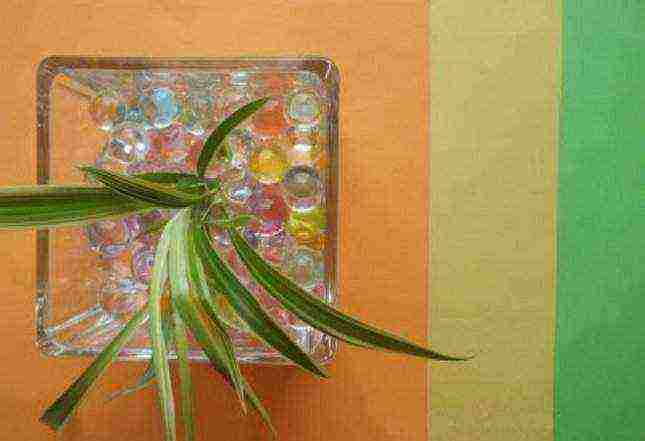
Plant in hydrogel
Features of care. Watering a plant planted in a hydrogel should be 6 times less frequent than plants in soil. The substance itself will tell you about the need for watering, which will begin to settle a little - this means that a lot of moisture has begun to leave it.
Planting plants in soil with hydrogel
Planting indoor flowers in such a soil greatly facilitates their care, because such plants can be watered less often. In addition, the hydrogel helps plants adapt to new conditions faster after transplanting.
How to properly formulate a hydrogel substrate?
1. The first step is to mix the substance with a suitable substrate. For 1 liter of soil, only 2-3 g of hydrogel is required.
2. Then the granules should be mixed well with the earth.
3. Now the resulting mixture must be watered abundantly so that it is well saturated, and the hydrogel has absorbed the required amount of moisture. Now plants can be planted in such land.
The hydrogel in the substrate retains its qualities for 3-5 years, so it is enough to add it to the ground once during planting.
What plants can be grown in a hydrogel? For growing in a hydrogel substrate, moisture-loving plants are suitable, as well as species that are suitable for growing in hydroponics. So, you can plant in soil with polymer chlorophytum, ivy, codiaum, kalanchoe... Some growers even grow succulents like this, for example, fat woman or spurge... And beautifully flowering Saintpaulias, petunias, gloxinias, when planted in a substrate with a hydrogel, even begin to grow more intensively and bloom more abundantly.
Features of care. Caring for plants planted in the ground with the addition of hydrogel granules is practically no different from ordinary care. The only thing to remember is not to water the plants too often.
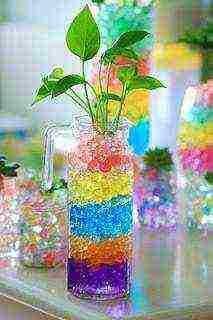
Today I will tell you about hydrogel for indoor plants and the features of its use. While still a student, and working on my thesis, I conducted an experiment on the use of a hydrogel as a component of a potting soil mixture for indoor plants.
Hydrogel Is a polymeric compound with an amazing ability to absorb, retain and release water to plants. It is absolutely non-toxic and completely safe for plants. The main sphere of its use is agriculture, but not so long ago, hydrogel began to be used in indoor floriculture and phytodesign.
It is very easy to create an original gift or just a bright decoration. Now hydrogel for indoor plants and phytodesign is available in various colors. The greatest effect is provided by the use of several shades - here it is already a matter of imagination (it should be noted that the consumption of hydrogel for planting one plant is small, and the price for it is acceptable).
The container for planting is chosen transparent, made of glass or plastic (with the exception of matte, with a pattern or with a cut) The shape of the container can be absolutely any and even contrary to the rules for selecting a pot, since the hydrogel is more plastic, easily removed, and there is no danger of injuring the roots when transplant. For small, rosette plants, glasses with a low stem are preferable, for larger ones, glass vases, high cylindrical or low round.
Hydrogel preparation
The hydrogel is poured with clean (filtered, settled or distilled water) at the rate of 200-300 ml per 1 g of dry matter. Complete swelling lasts about two hours.
Houseplant selection
Indoor plants that require rare watering (succulents, some epiphytes), with dense leathery leaves or storing water in tubers and roots are not suitable for growing in hydrogel.
Dracaena, cordilins, shefflers, codiaums, unpretentious chlorophytums, tradescantia, syngoniums, scindapsus, cyperus, ivy adapt well in hydrogel.
Spathiphyllum, arrowroot, aglaonema, sensevieria, and ficus are suitable for shaded or lacking sufficient lighting places, you can try to grow flowering anthuriums, Kalanchoe, Tilandsia, Guzmania and others on hydrogel.
Planting indoor plants in a hydrogel
It does not fundamentally differ from planting in the ground, fixing the plant in an upright position can become a possible problem. Before planting, the roots are thoroughly washed from the soil and carefully laid out on the surface of the hydrogel and then covered with the hydrogel to the desired level.
Caring for indoor plants in a hydroget
Over time, the roots grow into granules, and the plant receives water without interruption. Watering is needed about 5-6 times less often and in a smaller volume, a sign for watering is the settling of the hydrogel. The plant is also fed less often, it is better to limit yourself to mineral fertilizers.
Replacing the hydrogel
Typically, the service life of the hydrogel is about 5 years. A sign for replacement is the destruction of granules, the formation of a shapeless mass, and less water absorption.
Well, this is all in theory, quite simple and understandable. And now a little of my experience of growing plants in a pure hydrogel.
I tried to grow a very unpretentious Tradescantia in a hydrogel. I renewed the old plant and planted several cuttings not in the soil but in the hydrogel. Despite the well-developed roots, the plant grew with difficulty, the shoots stretched out, as if they did not have enough light, although the same Tradescantia, but felt much better in the soil. The leaves became pale, dull, thin, to the touch like rags.
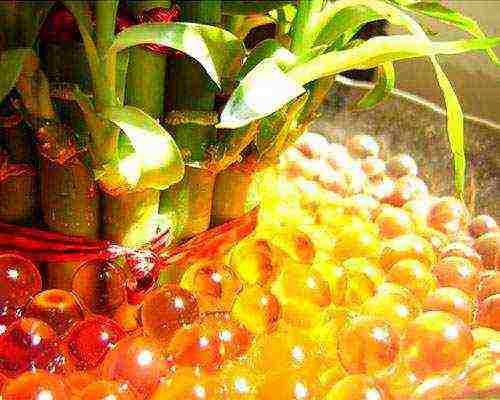
Much better in fuchsia hydrogel. It turned out that several cuttings had to be urgently planted, but not where. In order not to disappear, I put it in a vase with a hydrogel. Of course, it grew very slowly, but outwardly it looked very healthy and even picked up the buds, but then dropped it. Fuchsias are extremely sensitive during budding, and they react to everything by immediately dropping buds and flowers.
Recently I decided to try again to grow an unpretentious plant in a pure hydrogel. Chlorophytum just required a transplant. The first hydrogel I used was TM Agricola. The hydrogel consisted of irregular granules, no more than a centimeter in height and width.
Nowadays, hydrogel comes in the form of balls, cubes, etc. I bought a colored gibrogel, which was shaped like parallelepipeds, cubes, etc. I was very surprised at the size. Some crystals, after swelling, reached the size of a walnut.
Even small in size chlorophytum was not easy to fix, in my opinion, the granules were too large.
It is also worth noting that the water evaporated catastrophically quickly, a couple of days and the hydrogel settled on almost half of the vase. The roots of the plant were bare, and the chlorophytum's appearance became more and more dejected every day.
Now I do not grow plants in pure hydrogel, but use g
idrogel as a soil component,
but such huge granules are completely unsuitable. And if the moisture evaporates so quickly, then there is no point in it at all.
As a result, I will say that the hydrogel is very decorative and with the help of it you can single out any plant as a tapeworm and give the room a special zest. But you will have to try both by mistakes and by trial to look for such a plant.
The hydrogel is characterized by the fact that it can absorb moisture and retain it for a long time, due to which it is often used in indoor floriculture and when growing seedlings.Previously, this polymer compound was widely used in the agricultural industry, but now phytodesigners and flower growers have turned to it. Tellingly, plants can be grown both directly in the hydrogel and in soil mixed with this substance. The moisture that is absorbed by the hydrogel does not flow out onto the tray and does not evaporate; moreover, it does not lose its original beneficial properties. So, today you will learn everything about hydrogel for plants - application, features, pros and cons. The article will also provide step-by-step instructions for using the polymer compound.

Plant hydrogel - application
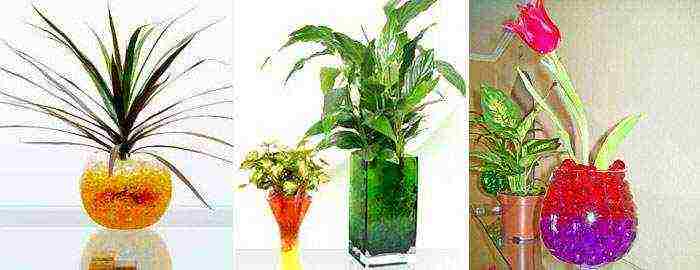
Using a hydrogel
Features of the use of material in crop production
A hydrogel is a polymer that makes great seedlings grow. Tellingly, when plants develop, they receive all the nutrients they need. First of all, the hydrogel is widely used to obtain seedlings.

Hydrogel Balls
To get high-quality seedlings, the gardener has to face a number of difficulties. So that the seedlings turn out to be healthy and strong, you need not only good lighting and a well-prepared soil mixture, but also competent watering. Moisture is very useful for young seedlings, but in excess it can lead to decay of the roots, which, in turn, will cause the subsequent death of plants. To avoid all these troubles, you can use a hydrogel, which has unique properties - it absorbs moisture and retains it for the full growth of the grown crops.

Miracle crystals or hydrogel
Note! The hydrogel is used as a planting substrate (a kind of container with water) or as a special additive that retains moisture for the prepared soil mixture.
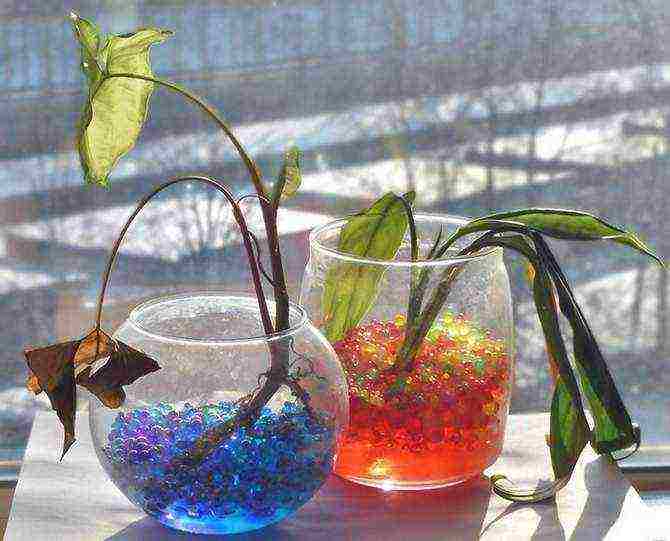
How is the hydrogel used?
The novelty, which appeared on the domestic market relatively recently, has already managed to acquire numerous admirers. If you start using it to grow indoor flowers or seedlings, you will no longer worry about watering and feeding young seedlings. This is explained by the fact that polymer granules absorb not only water, but also fertilizers in liquid form, due to which food is supplied as needed. It turns out that hydrogel is the ideal material for minimizing plant care, as well as reducing stress during traumatic soil transplantation.
The material is sold in the form of small beads like beads. If you add water to these balls, they swell, after which the polymer is ready for further use.
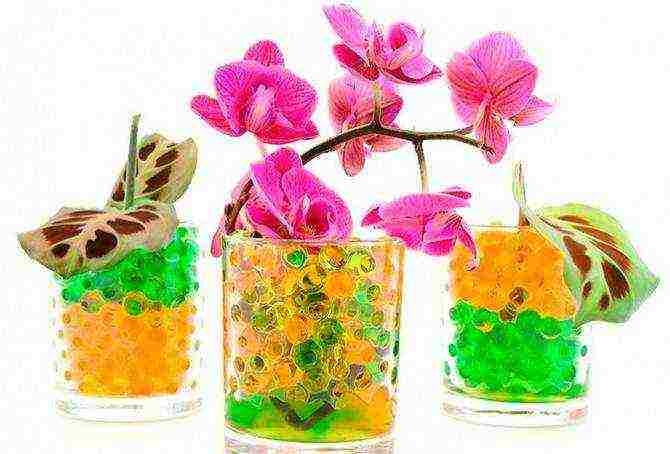
Indoor plant hydrogel
Advantages and Disadvantages of Using a Hydrogel
Despite the effectiveness and certain popularity, the described polymer granules have not yet found mass distribution. First of all, this is due to their recent appearance on the domestic market and the fact that most of the buyers do not know about the advantages of the material. And so that you don't have any doubts, let's get acquainted with the pros and cons of using a hydrogel.

Plant hydrogel
As for the benefits, these include:
- increased moisture absorption (granules absorb 300 times their own weight), which allows maintaining the substrate moisture level required for plants for a long time;
- economy (to get 1 liter of base, only 1-1.6 g of dry granules are enough);
- earlier seed growth when compared with traditional cultivation;
- preservation of all trace elements present in the substrate (they are not washed out);
- high-quality aeration of seeds and roots.
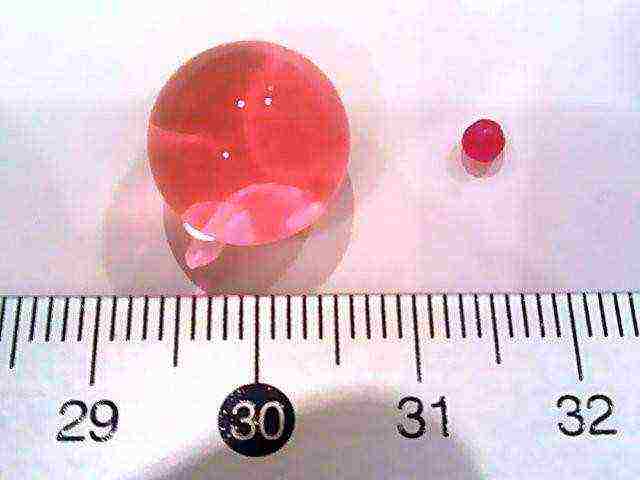
Dry and swollen granules of material
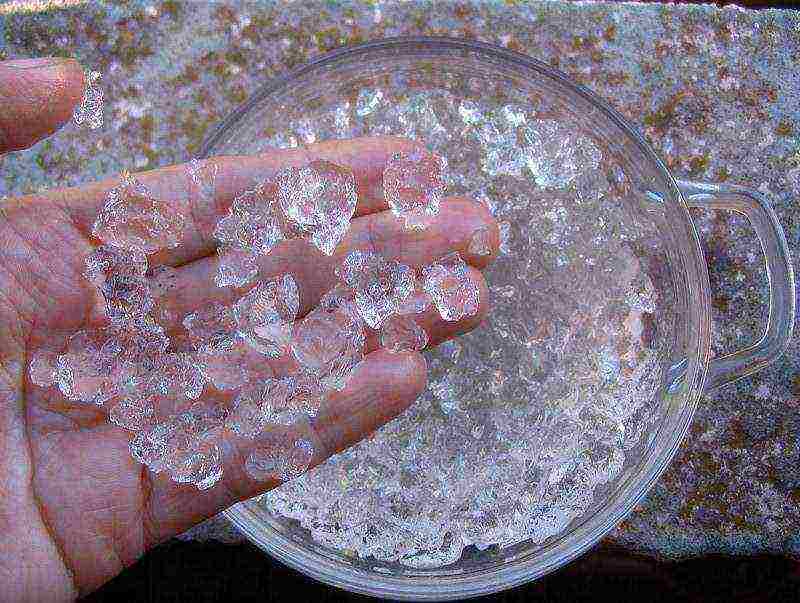
The hydrogel has absorbed water
However, there are disadvantages that you also need to know about before buying a hydrogel.
- You cannot grow crops in a hydrogel that have leathery seeds (such as sweet peas).In addition, when adding seed to a hydrogel, you must take into account the individual characteristics of a particular crop.
- It is also necessary to maintain the required temperature of the surface where the plants with the hydrogel are located - this will prevent hypothermia of the seedlings.
- Finally, the granules should not be reused, even if the manufacturers claim otherwise. The fact is that the already used hydrogel loses its absorbing properties, in addition, it becomes dark and wrinkles. Finally, bacteria can easily develop on the pellets after exposure to air. Therefore, the only thing this material will do is to use it in the form of a moisture-retaining additive for a soil mixture.

Indoor flowers in hydrogel
Note! Thanks to all the advantages and disadvantages of the material listed above, you can objectively assess your own capabilities and the likelihood of obtaining healthy plants.
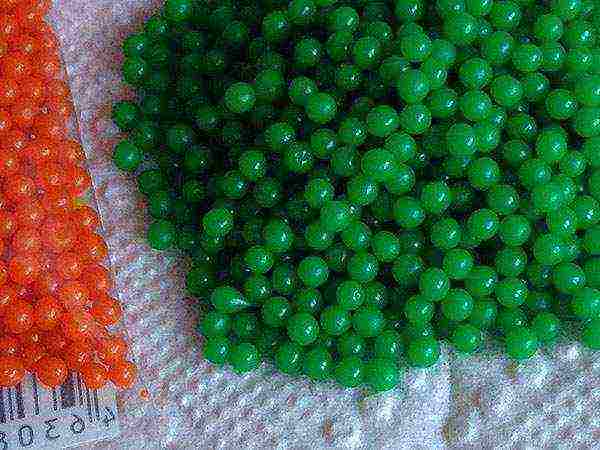
Hydrogel
The main ways to use the hydrogel
There are several ways to use polymer granules at once, let's take a closer look at each of them.
Table. Methods of using the hydrogel.
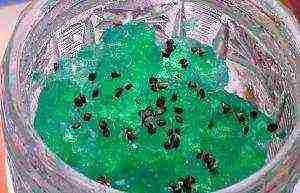 Method # 1 |
The seeds are placed in pre-prepared material. First, the granules are soaked, then crushed with a blender or grind through a sieve - as a result, a homogeneous mixture should be obtained. A 3 cm thick layer of hydrogel is placed in the pot, and seeds are placed on top of it, pressing a little. Excessive deepening of the seed is undesirable, because it can remain without oxygen, and this will negatively affect the quality of seedlings. After planting, the pots are covered with foil to ensure the desired microclimate. The cover can be removed daily to ventilate crops and remove condensation. |
 Method number 2 |
The hydrogel is also used as a moisture-absorbing additive in the soil mixture, which also gives excellent results. Here dry granules are mixed with the substrate (1: 3 or 1: 4), and the resulting mass is poured into a container. |
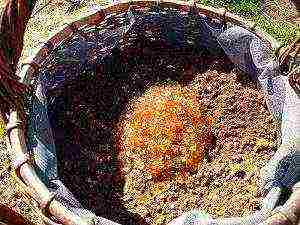 Method number 3 |
The last option is to use a hydrogel when planting in open soil. The roots are dipped into the swollen mass, and the seedlings are placed in the holes. Thanks to this, stress is reduced, and the plants are provided with moisture for the first time. |
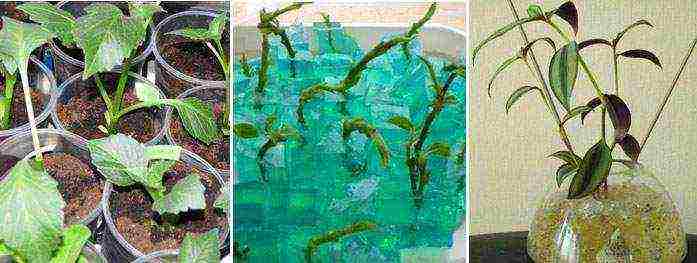
In a mixture of hydrogel and earth, it is very convenient to grow plant cuttings, germinate seeds. Prepare such a mixture in the same way as a mixture for indoor plants.
Note! Hydrogel is an environmentally friendly material that stimulates the growth of crops and has a positive effect on the quality of the soil.
Video - How to germinate seeds with hydrogel
Features of growing in a hydrogel
Today, the hydrogel is sold in different colors, so the plant in it may well turn into a decoration, a beautiful and original composition. The material is not very expensive, and if we consider that its consumption is insignificant, then we can assume that the bag will last for a fairly long time.

Hydrogel granules
Capacities... They must be transparent so that the granules of the material are clearly visible. The shape of the dishes does not matter at all, because when planting plants, the risk of damage to the roots is minimal. If the culture is small and grows with rosettes, then you can take a glass goblet for it, and if the plant is larger, then a vase will do.
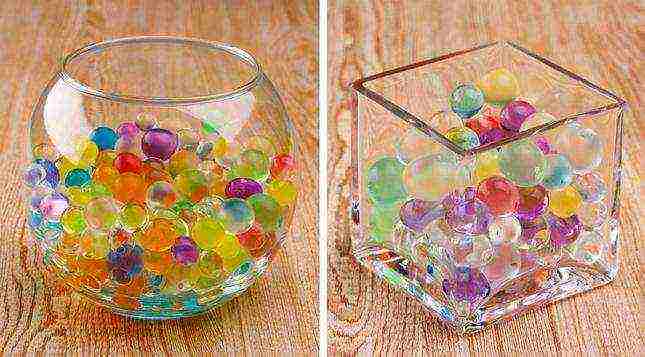
Glass containers with hydrogel
How to prepare a hydrogel... It is filled with purified distilled / settled water (about 300 ml per 1 g of material). More precise proportions should be indicated by the manufacturer on the packaging.
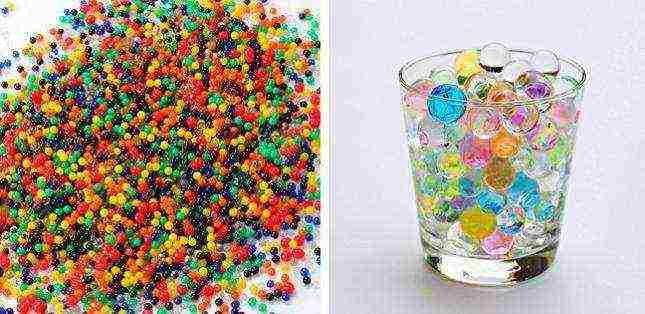
Hydrogel
Note! Do not grow plants in this way that need frequent watering. For example, epiphytes and succulents for the most part store moisture in the root system and leaves, and therefore staying in a humid environment can cause decay.
Landing features... The procedure is not much different from planting in ordinary soil.The container is filled with swollen granules, then a plant with pre-washed roots is placed there. If seeds are planted for seedlings, then the hydrogel after swelling must be crushed, as mentioned earlier. In a word, everything is quite simple. It is only necessary that the plants be in a strictly vertical position (and this can be difficult, since the material is very slippery).
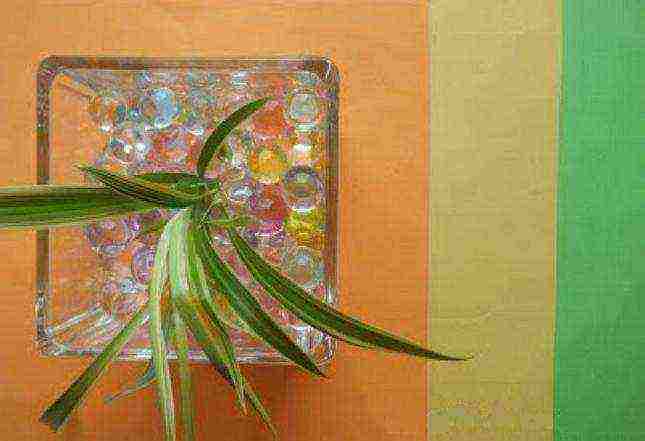
Plant in hydrogel
How to care... Watering should be done six times less often than with traditional cultivation. The fact that plants need to be watered can be understood by a slightly settled hydrogel (evidence of a large amount of moisture leaving).
How to plant a plant in soil with a hydrogel - step by step instructions
If you plant an indoor flower in such soil, then it will greatly facilitate the care of it. Moreover, the substance will help the flower quickly get used to new conditions.
Step one... First, mix the hydrogel with the prepared potting soil. Approximate proportions are 2-3 grams of substance per 1 liter of soil.

Hydrogel is added to the soil
Step two... After that, thoroughly mix the granules with the soil.
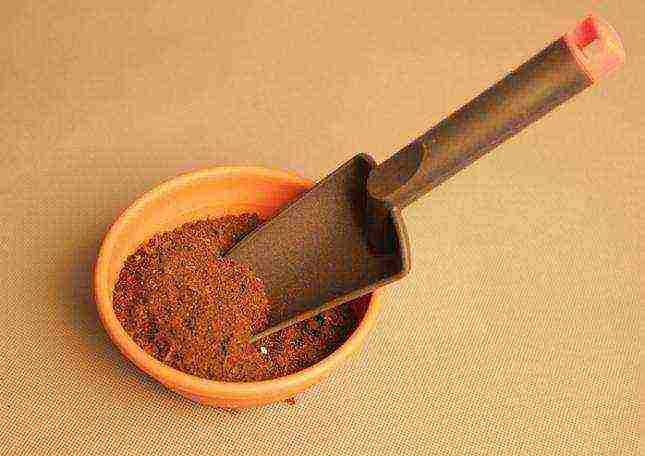
The granules are mixed with the ground
Step three... Pour the resulting mixture well so that it is saturated and the substance absorbed enough liquid. After that, you can proceed directly to planting plants.

Watering the mixture
Note! Polymer granules do not lose their original qualities for 3-6 years, which means that they can be applied only once directly during planting.

Plant grown in hydrogel
What cultures are suitable for this?
If we talk about a mixture of substrate and hydrogel, then moisture-loving crops are more suitable for this, as well as those plants that are suitable for hydroponic cultivation. Among indoor plants in soil with polymer, chlorophytum, euphorbia, ivy, bastard, Kalanchoe and others feel great. And beautiful petunias or saintpaulias after planting in such a substrate will develop faster and bloom better.
As for the care of crops planted in soil with hydrogel, it is almost the same as in conventional cultivation. The only exception is watering - in this case, it should not be too frequent.
How to germinate greens with a hydrogel
According to doctors, the daily use of greens helps to maintain health and youth for many years. And it is quite obvious that freshly picked greens are the most useful. In the summer it is grown in the beds, but in the winter you can arrange a small "vegetable garden" on the windowsill.
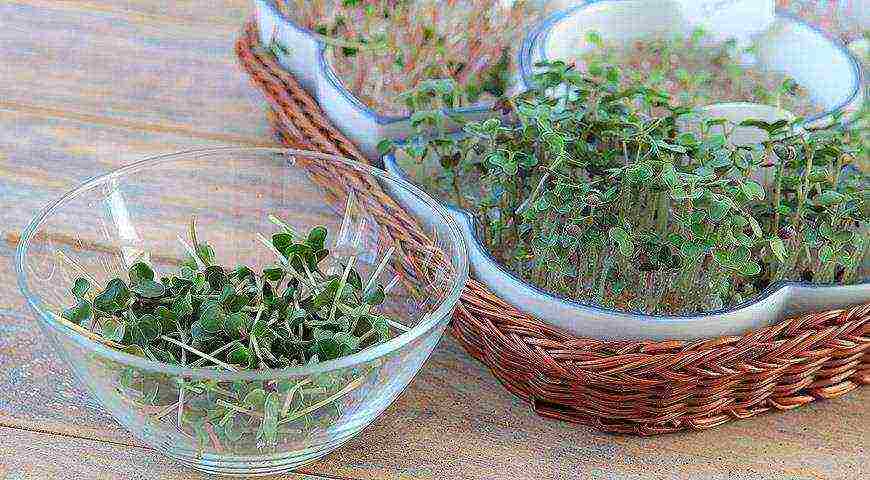
Germinating greens in a hydrogel
Before getting started, prepare:
- seed material;
- hydrogel;
- sowing containers.
After preparing everything necessary, proceed in accordance with the instructions. For the convenience of site visitors, it is shown in the form of a table.
Table. Do-it-yourself greens in a hydrogel.
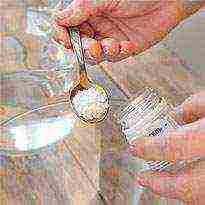 Step one |
To get started, take the hydrogel balls, put them in a large bowl, fill them with water and keep them at room temperature for 8 hours. |
 Step two |
When the material has swollen, place it in the planting containers. Remove excess liquid (if any) by discarding the balls in a colander. |
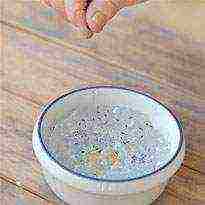 Step three |
Spread the seeds over the surface of the hydrogel, but do not cover. Do not wet them in advance - the granules will provide the seed with the amount of moisture necessary for germination. |
 Step four |
When the seedlings reach about 4-5 centimeters in size, you can start harvesting. And the containers that have become empty can be used for a new sowing. |
How to water aloe at home
If experienced growers know well what conditions are needed for aloe, then a beginner may find the growing technology and ensuring proper care for it rather complicated. For example, it can be helpful to learn how to water aloe at home.
Video - Tips for growing in a hydrogel
 On the shop windows for flowers and in garden supermarkets, you can see boxes and jars with translucent balls of different colors.
On the shop windows for flowers and in garden supermarkets, you can see boxes and jars with translucent balls of different colors.
They not only decorate the space of the house, but also provide moisture to the cut plants.
And if they are added when transplanting into a pot, then such plants will need to be watered several times less.
You can also use this substance, called a hydrogel, to keep the seeds moist for the winter, or soak them for germination.
Hydrogel. General information
A hydrogel is a polymer (it contains polyacrylamide and potassium polyacrylate) that can retain moisture for a long time.
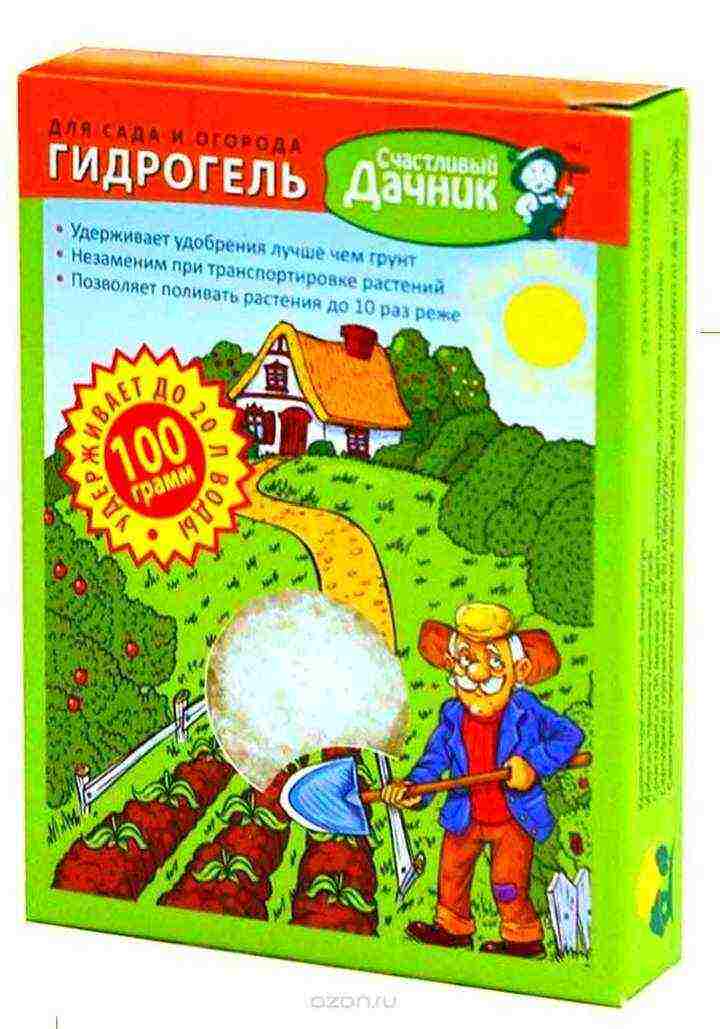 It was developed specifically for plants so that the chemical composition does not harm the life of flowers and seeds.
It was developed specifically for plants so that the chemical composition does not harm the life of flowers and seeds.
Despite the fact that the roots and stems during cutting will always be in a humid environment, rotting of the roots and cut parts does not occur.
Shelf life of the gel - three years, which means that it can be applied only once to the soil and during this time you can forget about additional measures of moisture. During the warranty period of use, it will repeatedly absorb moisture and give it to plants without losing its properties.
To understand where and how to use an absorbent in horticulture and home gardening, you need to get acquainted with the main characteristics of the substance.
Forms of issue
The hydrogel is on sale:
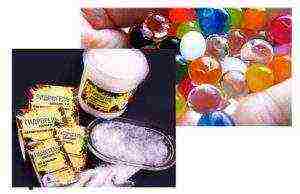 dry,
dry,- in the form of granules or
- powder, painted in various colors.
However, the difference in color does not affect the quality of the gel. After watering with water, the hydrogel swells and turns into a jelly-like mass or balls, which can be used to decorate transparent vases with flowers.
But this use case is good for cut flowers. For plants with a root system, seedlings or seedlings, the absorbent should be used according to the manufacturer's recommendation only in combination with soil.
Properties
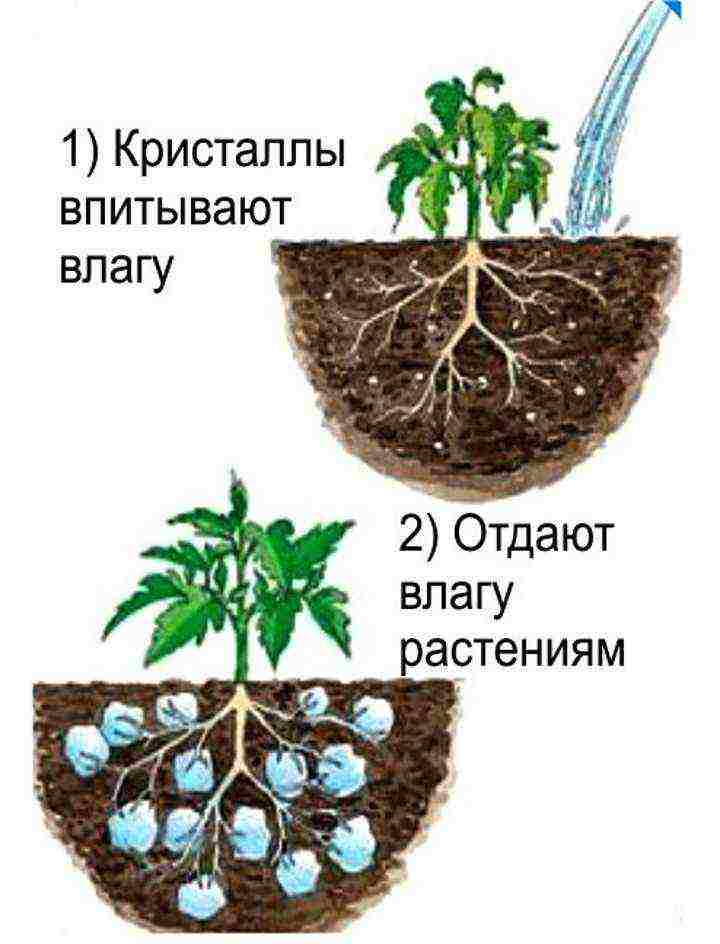 The polymer used in the manufacture of the gel can absorb a large volume of liquid, 100-200 times its own weight (up to 200 grams of water per ball).
The polymer used in the manufacture of the gel can absorb a large volume of liquid, 100-200 times its own weight (up to 200 grams of water per ball).
At the same time, she, as it were, grasps and lingers inside for a long time.
Flowers and seedlings can run their roots into the hydrogel and receive moisture from there, and watering is reduced to 1 time in 2-3 weeks.
After the balls fully return the moisture to the plants, a new watering is performed and the balls swell again. At the same time, the roots of the plant are protected from decay.
Varieties
Currently, the polymer is produced and marketed in two variations, the action of which is slightly different.
Soft polymer
 The granules are colorless. Plant roots penetrate easily and receive water.
The granules are colorless. Plant roots penetrate easily and receive water.
Suitable for moisture-loving flower varieties that cannot be watered frequently. Also used in horticulture and horticulture, if you need to germinate cuttings and grow seedlings.
For this purpose, the polymer is mixed with the soil. This version of the polymer is used to fertilize plants: it is watered with water mixed with fertilizers. The hydrogel absorbs nutrients and gradually releases them to the plants.
Dense polymer (aqua soil)
It is a gel that has a certain shape when it is sold: balls, cubes, triangles and is painted in different colors. It can be used to germinate seeds and store bouquets.

If an aromatic additive is added to the aqua soil together with water, then the polymer can be used as an air freshener.
Price
The hydrogel, which can now be easily found on the shelves, is a very budget purchase!
At the same time, manufacturers guarantee complete environmental safety for humans, the environment and plants.

The warranty period is three years, after which the polymer loses its shape, but not the ability to absorb. There are no recommendations for its disposal, you can simply take it out into the garden and bury it in the beds.
Appointment
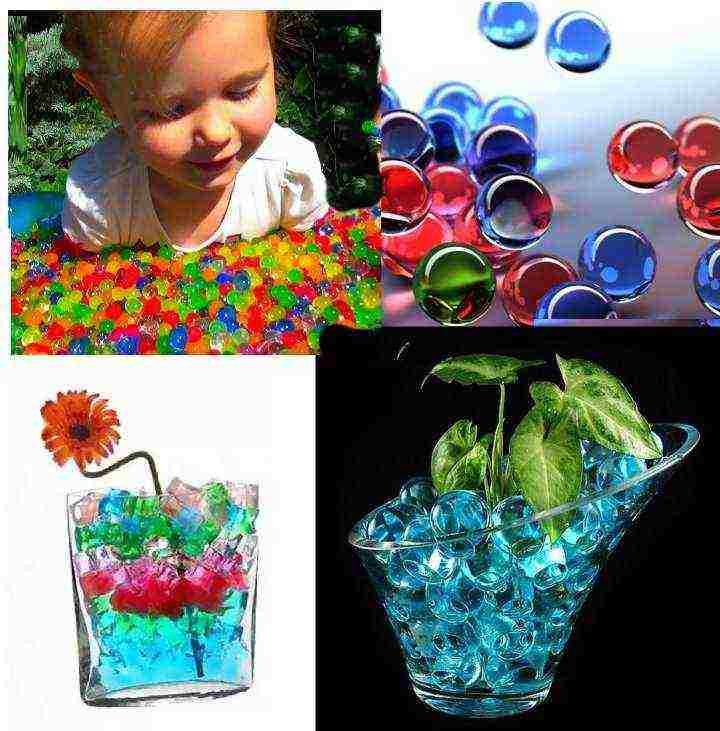 for preparing a mixture of soil;
for preparing a mixture of soil;- for moisture-loving plants;
- if it is not possible to water the plants often;
- for plants access to which is difficult;
- for plant nutrition;
- for germinating cuttings;
- for bouquets;
- when growing seedlings;
- for aromatization of the room;
- for air humidification;
- for room decor;
- to give the desired soil structure: the clay soil will loosen, and the sandy soil will hold it together.
Hydrogel analogs
Florists and gardeners often use other materials in their activities that have similar properties, but are still inferior to the hydrogel in terms of the amount of absorbed and retained water:
- vermiculite and perlite,
- coconut flakes.
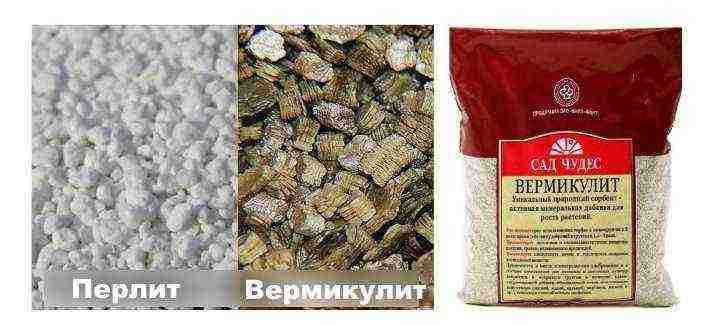
All of them are of natural origin and, in addition to storing moisture, these substances have several functions:
- vermiculite loosens the soil and promotes oxygen access to the roots;
- coconut fiberbesides the ability to absorb moisture, it is a completely degradable material and provides nourishment to the roots. It is often used as an adjunct in orchid soil and as a mulch for other plants.

Hydrogel application
What plants are suitable for
Despite the described characteristics and ease of use, the hydrogel is not suitable for all plants. For example, succulents themselves are able to accumulate moisture in various parts of the plant and do not need the action of a hydrogel.
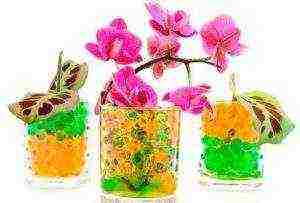 Orchids respond positively to the use of a hydrogel. In addition to the fact that it is added to the soil, sometimes you can even use aqua soil, while the stunning beauty of the flower will look favorably in a vase with multi-colored balls.
Orchids respond positively to the use of a hydrogel. In addition to the fact that it is added to the soil, sometimes you can even use aqua soil, while the stunning beauty of the flower will look favorably in a vase with multi-colored balls.
For most flowering and decorative deciduous, especially tropical ones, requiring moisture not only in the soil, but also in the air.
General recommendations when choosing a plant
In order not to harm the flower, you need to study the recommendations of the manufacturers on the use of the hydrogel and select flowers to which we will add the polymer, based on the advice.
This will eliminate mistakes and failures, and will make growing plants more convenient and enjoyable.
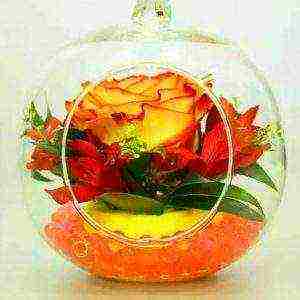 the flower should not be large, otherwise it will tilt, because the hydrogel can provide moisture, and not support;
the flower should not be large, otherwise it will tilt, because the hydrogel can provide moisture, and not support;- the plant must have well-developed, long roots;
- necessary for flowers growing in cramped pots;
- The hydrogel will not work for light-loving plants, but for shade-tolerant plants, yes;
- dense, leathery leaves are a sign of abandoning polymer.
Preparation for use
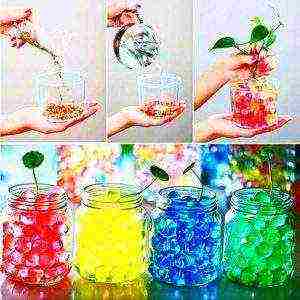 Soak the granules in water. From two tablespoons of dry matter, three liters of the finished hydrogel are obtained.
Soak the granules in water. From two tablespoons of dry matter, three liters of the finished hydrogel are obtained.- After the granules have swollen, they are poured into a colander so that the excess water is glass.
- If you have made too much hydrogel, you can pack it in a bag and place it in the refrigerator.
- For a solid polymer: we wait 9-11 hours and apply a hydrogel for plants, while balls of different colors can be mixed for greater decorative effect.
- We use the soft hydrogel one hour after swelling.
Use for seedlings
The hydrogel was originally developed for agricultural purposes. And, despite the fact that later it began to be used in indoor floriculture, the use in the industry remains relevant.
It is used for germinating seeds of vegetable and spicy crops and for rooting cuttings. In these cases, a pure hydrogel is used, without the addition of a primer. In some cases, fertilizers are added to the hydrogel along with water.
If the seeds are small, then the hydrogel can be crushed by passing through a sieve or in a blender.
Nylon fabric or agrofiber (a small piece) is used - the seeds are placed in the fabric and located in the hydrogel, so moisture will be available to the seeds and they will not be lost.

Large seeds placed in a hydrogel, slightly pressing them into the mass, so that part of the seed is in the gel, and part in the air. After that, the container with seeds is covered with foil.
Hydrogel for seed germination can be used with the addition of soil, this will avoid the stage of planting germinated seeds in the soil.
For this, the hydrogel is mixed with earth (1: 4) and placed in seedling boxes, and the seeds are also placed there, deepening according to agricultural technology.
Transfer
If you need to add a hydrogel to a houseplant, follow the instructions and soak the gel before adding it.
It is not recommended to add hydrogel in dry form to pots with indoor plants, otherwise, when swelling, the absorbent can displace the flower from the pot.
 the flower is carefully removed from the pot along with a lump of earth;
the flower is carefully removed from the pot along with a lump of earth;- shake off excess soil so that the roots of the plant remain intact;
- washed the roots under running water;
- pour drainage and a little soil into a new pot;
- set the flower and spread the roots well;
- fall asleep to the level of plant growth with a mixture of earth and hydrogel. From above, the soil with the gel is moistened with a spray bottle.
Cautions
 Do not leave the hydrogel pot in direct sunlight... Due to the sunlight, the balls will turn green, as blue-green algae will begin to develop there.
Do not leave the hydrogel pot in direct sunlight... Due to the sunlight, the balls will turn green, as blue-green algae will begin to develop there.- Water the plants every 2 weeks... Excess water from the sump must be drained.
- Do not add dry hydrogel to flower pots, when watering, it swells greatly and displaces the flower.
- In indoor floriculture, it is not recommended to add a lot of hydrogel to the pot.if the flower is large. The absorbent is soft and will not be able to keep the flower from falling or tilting.
Reviews of florists and gardeners
Domestic gardeners and florists prefer a soft hydrogel in their work, it helps to facilitate the care of plants and reduce the burden on people.

If, when working with indoor plants, the hydrogel is pre-soaked, then in the garden and in the garden the absorbent is used in a dry form.
It is introduced into the beds and planting holes, and only then the plants are watered abundantly. After that, the gel acts in the same way as at home: it absorbs moisture and gradually gives it to the plants.
This is very convenient if the agricultural region is arid or the amount of rain is minimal and not enough for natural irrigation of plantings.
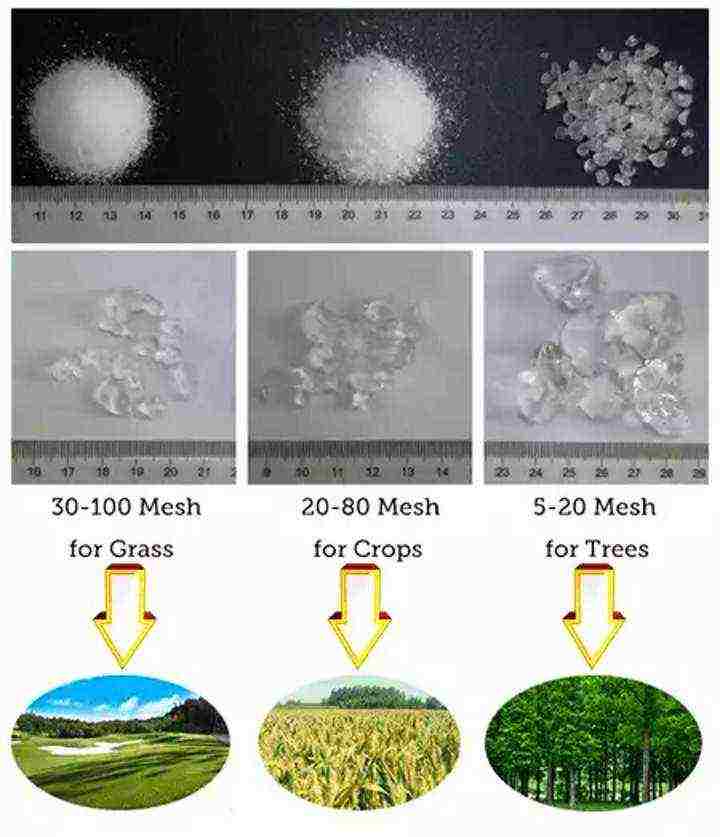
Gardeners hydrogel is recommended for growing:
- radish and other root crops;
- pumpkin seeds: cucumbers, zucchini, pumpkins, lagenarium, momordiki, etc .;
- tomatoes;
- strawberries;
- shrubs and trees;
- for arranging lawns and landscaping.
After the expiration date, the gel breaks down into water, carbon dioxide and ammonium - all these substances are environmentally friendly and do not harm either people, nature or the plants that they nourished.
TOP proven suburban shops in the Russian Federation - Choose, buy!
- - "Garden and Vegetable Garden" - Gardens of Russia is an online store of seeds and seedlings.
- - "Becker" is a popular store of seedlings, seeds, bulbs, delivery all over Russia!
